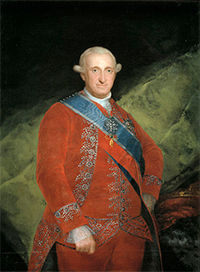King Charles IV of Spain
Part 2: A Reluctant King Charles had not really missed being instructed in the affairs of state, much preferring the joys of hunting and the outdoors. When he became King of Spain, he carried over his father's advisors and left the running of the country largely to them and to his wife, who had a very powerful personality and enjoyed enormous influence over her husband, in their home life and in their public life, including in his reign. 

Charles retained the Count of Floridablanca as Chief Minister. That statesman served in that position for four years, until internal politics led to his ouster, in favor of first the Count of Aranda and then Manuel de Godoy (right), the favorite of Queen Maria Luisa. Godoy it was who guided Spain into an alliance with other powers against Revolutionary France in the War of the First Coalition. Charles had spoken out publicly against the execution of France's King Louis XVI, and France had declared war on Spain in 1793. Spanish troops advanced through the Pyrenees and had success for a time. A French invasion of Spain in 1794 convinced Charles and Godoy to sue for peace. In 1795, France and Spain agreed to stop fighting each other, by signing two agreements. The Peace of Basle stopped the fighting; the Treaty of San Ildefonso (1796) created an alliance between the two countries against Great Britain. Spain supported the Continental Blockade against Britain. Both alliance and support ended after the British victory over French forces at the Battle of Trafalgar. Watching closely the progress of France's various wars with its other neighbors, Godoy again sought an alliance with France, in 1807, after French forces crushed a Prussian force and then a Russian force and regained supremacy on the Continent. 
In that same year, Charles's son, Crown Prince Ferdinand (right), led a rebellion, claiming the Spanish throne for himself. He had marshaled public opinion against his father and convinced many people that he would be a better monarch. Ferdinand had gained widespread support for his plan to replace his father, and Charles IV abdicated the throne on March 19, 1808. King Ferdinand VII then ruled Spain.
As part of Spain's alliance with France, the French emperor, Napoleon Bonaparte, had stationed tens of thousands of soldiers in Spain, ostensibly to protect against invasion by Great Britain but also to remind Spain that it had thrown in its lot with the French. Bonaparte summoned both Charles and Ferdinand to a meeting at the French location of Bayonne in April. At that meeting, Bonaparte forced Ferdinand to abdicate and prevented Charles from retaking the throne, giving it instead to Joseph Bonaparte, the emperor's brother. This began the Peninsular War. Charles and his wife and even First Minister Godoy spent several years in France, as captives. When Bonaparte finally released him, in 1813, Charles decided to settle in Rome. He died there on Jan. 20, 1819. Ferdinand, released at the same time, became King Ferdinand VII. Charles and Maria Luisa together had 14 children, six of whom survived into adulthood:
First page > Not the Makings of a Monarch > Page 1, 2 |
|
Social Studies for Kids
copyright 2002–2025
David White





